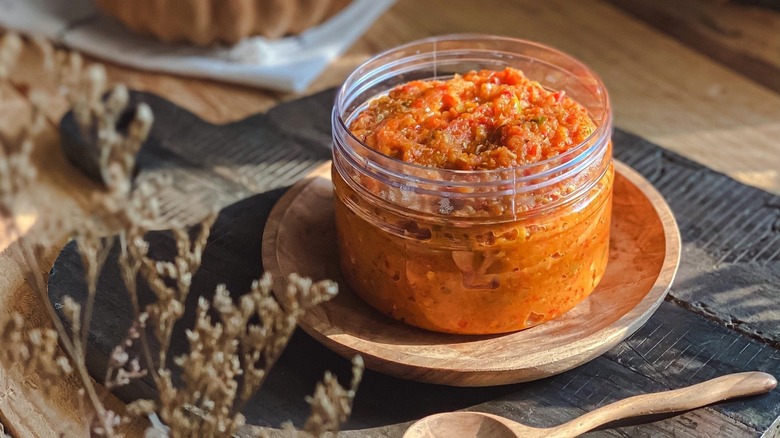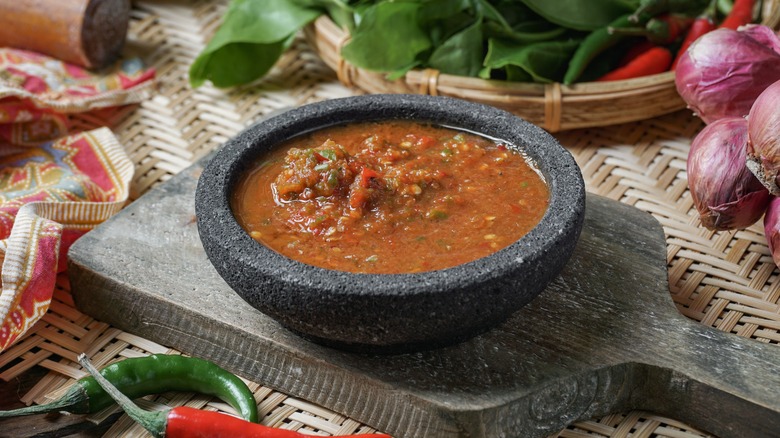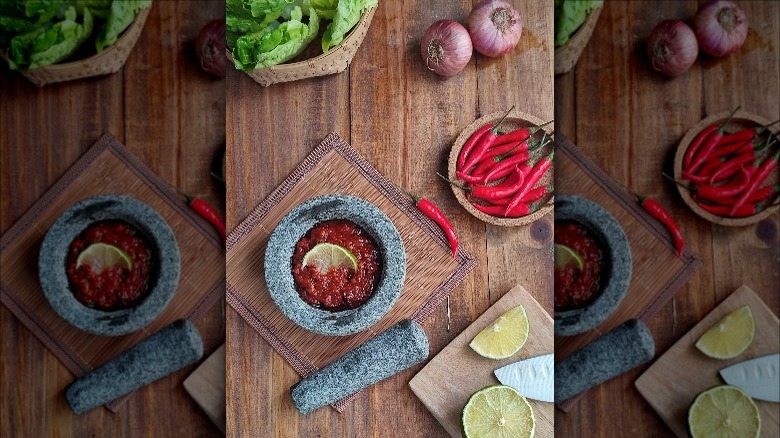Sambal Belacan: The Spicy Malaysian Chile Paste With An Unexpected Ingredient
If your family is the type that loves dishes when they have a spicy kick to them, you're certainly in good company. Although the very first version of hot sauce was incredibly simple, things have gotten more complicated over time. Today, there are a ton of different varieties, and if you love hot sauce, you should definitely start experimenting with chile pastes.
Chile pastes are great in a variety of dishes, from sauces and soups to dips. They're basically made from ground chile peppers, and while there are all kinds of pastes with different flavor profiles, we're going to talk about sambal. It is a Malaysian paste that — although it comes in many, many varieties — is a fermented chile paste that comes in a range of spice levels with a lime kick.
One of the most distinctive varieties is sambal belacan, a salty, flavorful paste that's sometimes just called belacan. It's popularly used across Southeast Asia, and it's pretty neat stuff. Even though it has a complex flavor of spice, heat, salt, and citrus, it can be made with just three ingredients. Chiles and lime are a given, of course, but the third one is unexpected: shrimp paste.
What does sambal belacan taste like, and how is it made?
Talking about what sambal belacan tastes like is tricky because there are so many varieties. It does, however, tend to be on the saltier side compared to other chile pastes, and that's entirely because of the shrimp paste — there's generally no extra salt added to the sauce.
So, what is this shrimp paste? It, too, is called simply belacan, and it's shrimp that's been fermented in salt, dried, and pressed into blocks. Before use, it's commonly roasted, and to some, the smell is ... well, pungent. But something fascinating happens, and it's not too different from what happens when you eat the stinkiest cheeses on earth. Once you get past the smell, it's absolutely divine: It's valued for adding a depth of flavor and an umami kick that's unparalleled. And it's been around for a long time, dating back centuries.
The other two ingredients are a little more straightforward. The type of lime that's most traditionally used is called calamansi, but if you're based in the U.S. and looking to try your hand at making some, the best substitute is key limes. As for the chiles, that's where things vary. Sambal belacan can be made with a few different types, which means it can range from a mild, red chile paste to a super-spicy green one.
How do you use sambal belacan?
One of the most popular ways to eat sambal belacan is also one of the simplest: On white rice. Warm rice with a side of sambal belacan is absolutely incredible, and if you're new to this particular chile paste, it's a great way to sample it in a way that will allow you to experience all the complexities of the brand and variety you choose.
Once you're familiar with the flavors, you'll know that the sky's the limit — and that it's a great way to add a kick to some of your favorite vegetables. It's the unexpected ingredient that adds loads of flavor to green beans and is amazing when used in a stir-fry, and that stir-fry can contain anything from carrots and cabbage to cauliflower and mushrooms. Love curry? Sambal belacan will shine in a curry. Love whipping up a noodle dish? Consider reaching for sambal belacan here, too.
Sambal belacan is also great with eggs, especially when used to coat hard-boiled eggs that can be served as a side or saved in the fridge for those moments when you're feeling just a tad hungry. You can also add it to your morning omelet on those mornings when you want something just a little extra spicy, and you can also opt to use it as an ingredient in things like marinades and sauces. In other words, if sambal belacan isn't already a staple in your kitchen, it should be.


